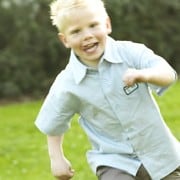5 Useful Tips for Teaching Kinesthetic Learners
This article was written in response to letter received by ACN Latitudes. A mother requested suggestions for helping her son, who has a kinesthetic learning style.
The frustrations of your eight-year-old son are shared by most kinesthetic learners throughout the country. These students achieve best by moving their large motor muscles as part of the lesson activity. This is in contrast to students who may be primarily auditory or visual learners. Fortunately, there are many effective techniques to help ensure academic success for kinesthetic learners. Unfortunately, very few teachers are aware of them or implement them in the classroom.
I offer these suggestions:
Reading Comprehension: Kinesthetic learners will retain information best if they can “experience” it. Try a technique I call “Virtual Experiential Reading.” While reading, your son should mentally pretend he is making a movie of the text. Encourage him to read a phrase and imagine he is acting out or experiencing the words. For example, if the sentence reads: “Johnny took his dog for a walk,” he should pretend that he is Johnny, and he should imagine the feeling and movement of walking the dog. If the phrase were, “It was much too hot to play soccer that day,” he should mentally feel the heat and picture the scene. He can do this with each phrase or sentence, and it will increase his ability to recall and comprehend what he has read. With practice it will become a habit. This approach can be used with most reading material.
Vocabulary Development: When your son is learning new vocabulary words, ask him to mentally or physically act out each word and its definition. Teachers usually do a good job of explaining the meaning of vocabulary words and using them in a sentence, but they don’t use this extra step to involve the kinesthetic learner. This is also a great idea when learning a foreign language.
Math: Basic math facts can also be learned kinesthetically. Try this. Take a set of paper plates and number them from one to 20. Lay them on the floor in a line in numerical order. To teach addition, have your son jump on the plates to match the problem. For example, for the problem 8 + 6, ask him to begin by standing on the #8 plate. Then ask him to jump onto the six next plates. He will land on #14, and should write his answer to the problem before beginning the next one. This activity will reinforce the concept of addition. Then teach him to jump in the other direction for subtraction.
Decoding or Phonics: If your son is having trouble with phonetic associations, he would benefit from using his large muscles to write the letters while he pronounces the sounds out loud. Some ways to do this are:
- Air writing: Have him stand up and form the letter, tracing it in large size in the air. He should use his entire writing arm. While forming the letter, he should pronounce the phonetic sound of the letter. He can then repeat this for each letter: five times while looking at the letter, and five times with his eyes closed.
- Walking the letters: Draw the letter about six feet in size with chalk on the sidewalk. In cold weather, use string or tape to make the letter on the floor inside your house. Have your son walk along the letter in the direction that the letter should be written when using good handwriting. While doing this, he should repeatedly say the sound of the letter. Hopping, skipping, or crawling along the lines of the letter can vary this technique.
- Writing on a large surface: One of the best approaches for kinesthetic learners is to stand at a flip chart, chalkboard or erasable board and write while saying the words or letters. The words or letters (oversized) can be traced or written freehand, using the entire arm.
Sports Math: Physical movement is an excellent reinforcer for kinesthetic learners. If your son is learning his multiplication tables and he answers one correctly, have him toss a ball (or a wad of paper) into a wastebasket, throw a dart at a wall board, shoot a Nerf basketball into the hoop, hit a soft mini-golf ball, or take a turn with an in-house toy bowling set, etc. Find a simple physical activity to reward his achievement. You’ll be surprised at how quickly he learns his math facts.
Ricki Linksman is the Director of the National Reading Diagnostics Institute, Naperville, IL.
Editor: Solving Your Child’s Reading Problems (Fine Communication, 1998) and How to Learn Anything Quickly (Citadel Press, 1996) by Ricki Linksman have many other ideas that can be shared with teachers to help students with a variety of learning styles.









